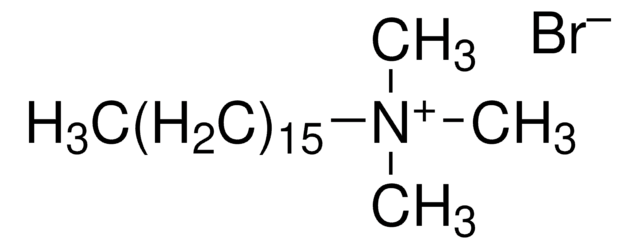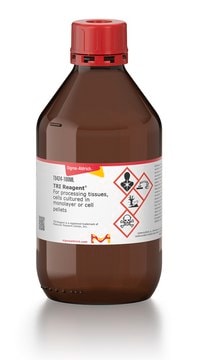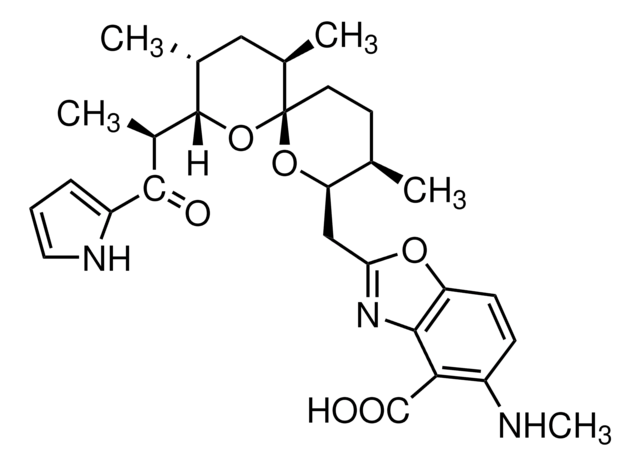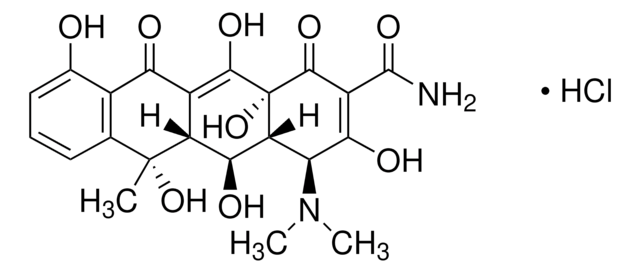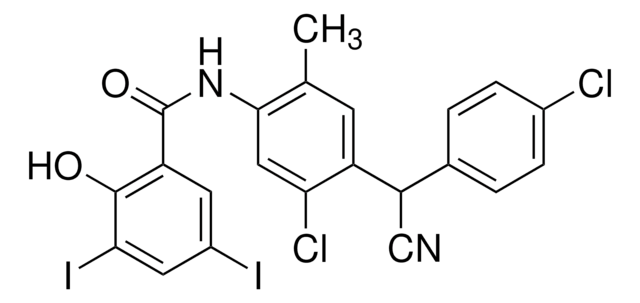Wszystkie zdjęcia(1)
Kluczowe dokumenty
R5628
Hae III from Haemophilus aegyptius
Restriction Enzyme
Zaloguj sięWyświetlanie cen organizacyjnych i kontraktowych
About This Item
Numer CAS:
Numer MDL:
Kod UNSPSC:
12352204
Polecane produkty
klasa czystości
Molecular Biology
for molecular biology
Formularz
buffered aqueous glycerol solution
stężenie
10,000 units/mL
Warunki transportu
wet ice
temp. przechowywania
−20°C
Szukasz podobnych produktów? Odwiedź Przewodnik dotyczący porównywania produktów
Specyficzność
Recognition sequence: 5′-GG/CC-3′
Ligation and recutting results: After 2-10-fold Hae III overdigestion of 1 μg λ DNA substrate, results in 100% cutting, >50% of fragments can be ligated, and >95% recut.
Heat inactivation: 80 °C for 20 minutes.
Ligation and recutting results: After 2-10-fold Hae III overdigestion of 1 μg λ DNA substrate, results in 100% cutting, >50% of fragments can be ligated, and >95% recut.
Heat inactivation: 80 °C for 20 minutes.
Zastosowanie
HaeIII is a restriction enzyme that is used in molecular biology methods to cleave DNA at the recognition site 5′-GG/CC-3′ to generate DNA fragments with blunt termini.
Inne uwagi
Supplied with 10x Restriction Enzyme Buffer SM (B3158).
Comment: Inefficient for single-stranded DNA cleavage.
Hae III requires optimal reaction conditions in order to avoid star activity.
Hae III requires optimal reaction conditions in order to avoid star activity.
Postać fizyczna
Solution in 20 mM Tris-HCl, pH 7.7, 0.1 mM EDTA, 400 mM NaCl, 10 mM 2-mercaptoethanol, 50% glycerol (v/v) at 4°C
Ta strona może zawierać tekst przetłumaczony maszynowo.
produkt powiązany
Kod klasy składowania
10 - Combustible liquids
Klasa zagrożenia wodnego (WGK)
WGK 2
Temperatura zapłonu (°F)
Not applicable
Temperatura zapłonu (°C)
Not applicable
Wybierz jedną z najnowszych wersji:
Masz już ten produkt?
Dokumenty związane z niedawno zakupionymi produktami zostały zamieszczone w Bibliotece dokumentów.
Stefano Fazi et al.
Environmental microbiology, 10(10), 2760-2772 (2008-07-23)
We studied the diversity, community composition and activity of the primary microbial colonizers of the water above freshly re-wetted sediments from a temporary river. Dried sediments, collected from Mulargia River (Sardinia, Italy), were covered with sterile freshwater in triplicate microcosms
Duplex regions in "single-stranded" phiX174 DNA are cleaved by a restriction endonuclease from Haemophilus aegyptius.
R W Blakesley et al.
The Journal of biological chemistry, 252(20), 7300-7306 (1977-10-25)
Beatrix Kotlan et al.
Journal of immunology (Baltimore, Md. : 1950), 175(4), 2278-2285 (2005-08-06)
The potential tumor-recognizing capacity of B cells infiltrating human breast carcinoma is an important aspect of breast cancer biology. As an experimental system, we used human medullary breast carcinoma because of its heavy B lymphocytic infiltration paralleled to a relatively
C Kessler et al.
Gene, 92(1-2), 1-248 (1990-08-16)
The properties and sources of all known class-I, class-II and class-III restriction endonucleases (ENases) and DNA modification methyltransferases (MTases) are listed and newly subclassified according to their sequence specificity. In addition, the enzymes are distinguished in a novel manner according
Cong Zhu et al.
Nucleic acids research, 41(4), 2455-2465 (2013-01-11)
Zinc-finger nucleases (ZFNs) have been used for genome engineering in a wide variety of organisms; however, it remains challenging to design effective ZFNs for many genomic sequences using publicly available zinc-finger modules. This limitation is in part because of potential
Nasz zespół naukowców ma doświadczenie we wszystkich obszarach badań, w tym w naukach przyrodniczych, materiałoznawstwie, syntezie chemicznej, chromatografii, analityce i wielu innych dziedzinach.
Skontaktuj się z zespołem ds. pomocy technicznej
